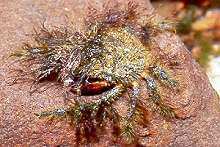At the other end of the scale, diversity of the places where species live (habitats) and the communities (associations of species) in which they live are equally important. This is where diversity of ecosystems comes in because the term ecosystem refers to:
A community of interdependent organisms together with the environment which they inhabit and with which they interact.
|
It is far more difficult to come to grips with ecosystem diversity than species or genetic diversity because the boundaries of communities are not easy to define.
The classification of the earth's great variety of ecosystems into a manageable scheme is currently a major challenge to scientists, especially when it comes to the marine environment.
However, this task is progressing rapidly and it is well worth looking at some of the major directions of this fascinating work.
Biogeography |

Decorator Crab |
Biogeography is the name given to the study of the distribution of life on earth. Biogeographers use a complex combination of the distribution of past and present life, geography and climate to currently recognise two major regions for Australia's coastline:
- The Northern Australian Region.
- The Southern Australian Region.
These two regions of overlap on the western and eastern shores of Australia.
Northern Australian Region
Open shores in northern Australia are typified by extensive growths of coral reefs. Sheltered shores support over 30 species of mangrove and have little salt marsh vegetation. Northern coral reefs have a high diversity of fish and invertebrates. However, only 10% to 15 % of northern Australian marine species are endemic (found only in that part of the world).
Southern Australian Region
Rocky shores in southern Australia are typified by extensive growths of massive brown seaweeds, called kelps. Sheltered shores support extensive salt marshes and only one species of mangrove. These shores have the world's highest diversity of seaweeds and some invertebrate groups. 80% to 90 % of southern Australian marine species are endemic.
A Matter of Definition
The two regions described above represent only one of the many schemes that research into Australian marine biogeography may uncover. Past schemes, for example, refer to as many as three tropical marine provinces and four temperate provinces around the shores of Australia.
For more information about marine bioregions and current work on the mapping of marine bioregions in Australia visit the Environment Australia web site at: www.environment.gov.au/marine/coastal_atlas/index.html
A Matter of Scale
The other factor that needs to be considered is that of scale. Humans see things at one particular scale and any creature less than a millimetre or so in size is easily neglected.
As far as marine ecosystems are concerned, this is a rather unfortunate oversight because many open ecosystems depend on the microscopic life that drifts about in the sunlit upper layers of the ocean. This microscopic life, called plankton, is the starting point of most open ocean food webs and therefore a vital part of marine ecosystems.
Scale also comes into play when it comes to ecosystem diversity because whole communities of microscopic organisms live out their lives by existing on or between the sand grains in marine sediments. Meiofauna is the name given to such microscopic animals that measure between 0.5 mm and 0.062 mm while the terms microfauna and microflora refer to any such organism less than 0.062 mm.
Next: Biodiversity in the sea
|